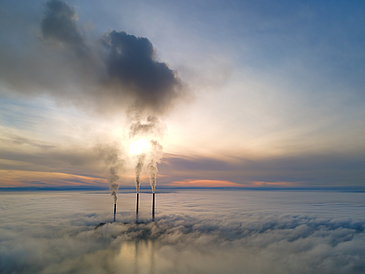Germany is currently investing billions of euros to significantly reduce greenhouse gas emissions from steelworks. This is to be achieved primarily by switching to hydrogen operations. But how do you actually measure the quantity of greenhouse gases produced during the production process? "Previously, we had to rely largely on data and calculations from steel manufacturers," says Dr. Heinrich Bovensmann from the Institute of Environmental Physics (IUP) at the University of Bremen. "We have now developed a method with which these releases can also be measured and calculated independently – using satellite data relating to the composition of the atmosphere."
The production of steel generates large quantities of carbon dioxide (CO2) and carbon monoxide (CO). In 2022, for example, German CO2 emissions from the production of pig iron and steel amounted to around 23.5 million tons, according to the Federal Environment Agency. The IUP researchers have known that these emissions can also be detected from space since the major moorland fire in Emsland in September and October 2018: "It wasn't an open fire, but one that was smouldering in the ground," says Heinrich Bovensmann. "A fire like that produces a lot of carbon monoxide, which we were able to visualize with the high-precision images from the Sentinel-5P earth observation satellite launched in 2017." What could also be seen, however, was a carbon monoxide plume from the Ruhr region – from Germany's largest steel site in Duisburg.
Tracking Carbon Monoxide with Satellites
From then on, postdoctoral researcher Oliver Schneising from the IUP team took an interest in these emissions and examined satellite data with regard to other German steel sites with integrated steelworks. He was able to prove beyond doubt that carbon monoxide was being released in Duisburg, Dillingen, Salzgitter, Bremen, and Eisenhüttenstadt. "Primary steel production worldwide is predominantly carried out using the so-called Linz-Donawitz process. In this process, oxygen is blown onto carbon-rich pig iron in order to minimize the carbon content by means of oxidation and thus obtain high-quality, low-carbon steel," explains the Bremen scientist. "The carbon monoxide – CO – released in the process can be better determined from space using the new generation of satellite sensors than the greenhouse gas CO2 itself."
In order to determine the CO emissions from the Earth remote sensing measurements, the Bremen researchers led by Schneising took a close look at the meteorological conditions – in particular the wind – at the time of the measurements. "We determined the CO emissions of the above-mentioned steel sites and compared them with the CO2 emissions reported by the steel manufacturers for the same period," says Schneising. "This analysis shows a very high correlation of CO with CO2 across all sites and therefore justifies determining the CO2 emissions from the CO observations." The method developed by the IUP research group has now been published in a renowned academic journal following peer review.
Greenhouse Gas Monitoring System for Germany in Development
The Institute of Environmental Physics' work on this topic is part of an extensive research initiative funded by the Federal Ministry of Education and Research (BMBF). It is entitled "Integrated Greenhouse Gas Monitoring System for Germany" (ITMS) and is being led by the German Weather Service and the Max Planck Institute for Biogeochemistry. "The ITMS project aims to develop and implement a system that combines atmospheric observations from the ground, from the air, and from space with high-resolution emission inventories and high-resolution atmospheric models. The project intends to use said system to monitor and document greenhouse gas sources and sinks," explains Dr. Heinrich Bovensmann from the IUP, which is coordinating Bremen's participation for the institute. "The University of Bremen is jointly responsible for a large part of the activities. It coordinates the activities in the area of observation data, whereby continuously collected data from measurement networks and satellites play an important role."
The research group from the Institute of Environmental Physics has now published its results in the prestigious "Atmospheric Chemistry and Physics" journal of the European Geosciences Union: https://acp.copernicus.org/articles/24/7609/2024/
Further information:
https://www.itms-germany.de/en
www.uni-bremen.de/en/
Contact:
Dr. Michael Buchwitz
University of Bremen
Institute of Environmental Physics (IUP)
Phone: +49 421 218-62086
Email: buchwitzprotect me ?!uni-bremenprotect me ?!.de

